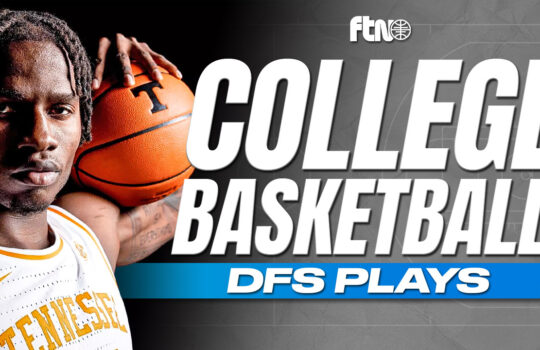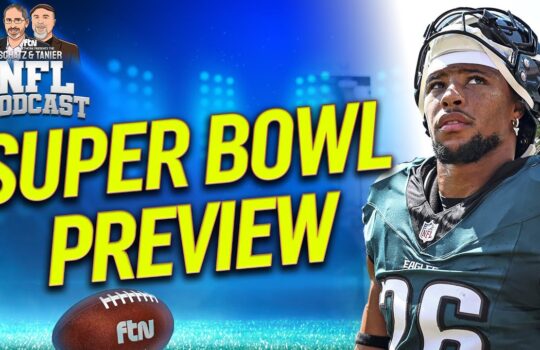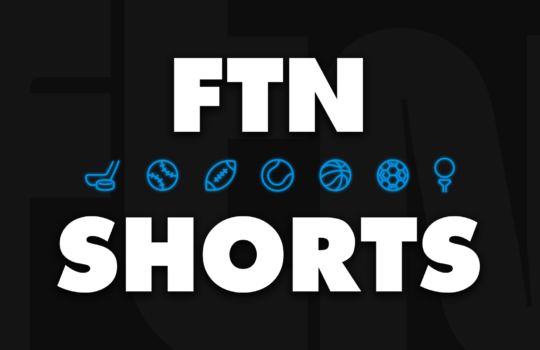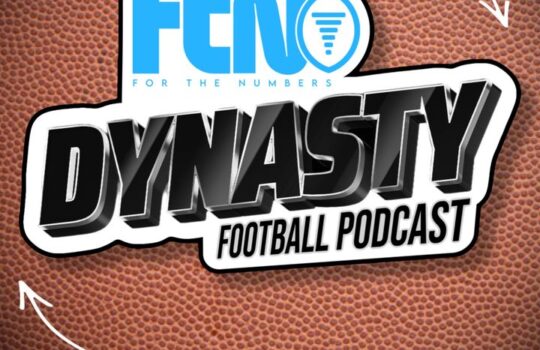
In my “not working for FTN” life, I also write novels. (Shameless self-promotion: Buy them!) That means that I spend a good portion of my life imagining what could be, rather than what is. And while flights of fancy aren’t necessarily the best way to do fantasy football analysis, it’s still nice to see how close we might have come to an entire different outcome in the season that was.
Every year, I like to indulge in an exercise I call “What if?” Change one small thing about the season (generally not “what if X hadn’t been injured?”, because you could wishcast health for every player) and take it to its logical conclusion. Change a weird draft pick, grant a player one big play before he loses his job, keep the Texans from trading away a superstar receiver … how might our perception of the season have changed?
Here’s a big one I’ve been playing with: What if Chuck Pagano never had leukemia? There’s an argument that his illness and the “Chuck Strong” phenomenon that followed has more or less ruined three different franchises for 2022 and going forward. That sort of thing.
Today, I’m looking at some of the key What Ifs of the 2022 fantasy football season. How close were we to a whole different year? Remember, this is mostly a flight of fancy. But it’s interesting.
Stats are all through Week 17, because that’s when the fantasy season ends, and it helps align us with seasons in the past.
What If … Jimmy Garoppolo Had Found a New Home?
Jimmy Garoppolo said his goodbyes to San Francisco after last year’s playoff loss, expecting to find a new home in the offseason. Only … he didn’t. He had shoulder surgery, the QB carousel worked fast, and by the time he was ready for a job, no one needed him. Even the thoughts of a late-preseason Teddy Bridgewater/Sam Bradford-esque situation didn’t come to fruition, so Garoppolo stuck around in San Francisco as the backup, and that became “as the starter” by Week 2, when Trey Lance got hurt.

Now, an important caveat here: The 49ers had Nate Sudfeld as their presumptive No. 2 quarterback until they knew Garoppolo was sticking around. So it’s possible Garoppolo’s departure would have kept Sudfeld around instead of casting Brock Purdy as the No. 2. But if we assume Purdy, not Sudfeld, would have taken over after Lance’s injury in Garoppolo’s absence, we can extrapolate some numbers:
- George Kittle averaged 11.7 PPR points per game this season in non-Purdy starts, but 15.7 with Purdy starting. The former number would have had him as a fringe fantasy starter; the latter would have had him not that far behind Travis Kelce for TE1.
- Brandon Aiyuk averaged 13.9 PPR PPG without Purdy (back-end WR2), but — even with Deebo Samuel hurt for some of the time — 13.4 with Purdy, and only that much after a huge Week 17. He was around 10 PPG with Purdy before Week 17.
- Christian McCaffrey is a star no matter what, but based on his numbers once joining San Francisco, he was a mid-tier RB1 (18.5 PPG) in Garoppolo’s starts, but the runaway No. 1 back in Purdy’s (25.8!).
Would the 49ers have trusted Mr. Irrelevant to take over from Week 2? Maybe not. But if they had, and if the Purdy/Kyle Shanahan combo had worked right away, there were some high ceilings in store.
What If … Christian Watson Catches That Long TD in Week 1?
It’s easy to forget now, but Christian Watson’s first NFL snap was a bomb from Aaron Rodgers on a route where Watson smoked Patrick Peterson. It would have been an easy walk-in 75-yard touchdown on a ball traveling more than 50 yards in the air … except Watson dropped it. It wouldn’t even have been a particularly difficult reception, as these things go. The famously finicky Rodgers didn’t target Watson again until late in the fourth quarter in garbage time, and Watson had only 52 receiving yards through his first two months in the NFL. He turned it on later, with eight touchdowns over the second half and multiple hundred-yard games before he was banged up heading into Week 17, but his career had a bit of a false start.

What if he had hauled in that easy touchdown, though? Would that have built trust between Watson and his Hall of Fame quarterback? Would early-season Watson have more resembled his late-season self? If he could have put up his second-half numbers in the first half, we’re looking at a rookie putting up 900-1,000 yards and double-digit touchdowns, and that’s a fantasy superstar instead of a “He could be interesting” type of guy.
On top of that, the Packers lost 22-27 in Week 5 in a game Watson had only 1 target. They lost 15-9 in Week 9 when he was targeted twice. When Watson had 6 targets or more, the Packers went 4-2; when he had 5 or fewer or missed the game, they went 4-6. Stretch the cutoff to 3 targets, the team was 7-3 when he had three targets or more and 1-5 when he had fewer or missed. Did light Watson use because of a single drop risk cost this team a secure playoff berth? They might still make it, but an extra win or two and we’d be talking about them as the 6-seed, maybe challenging for the 5.
What If … Chicago Had Unleashed Justin Fields Sooner?
Justin Fields was the fantasy QB5 this season. He’s got a shot at the QB rushing record with 64 yards in Week 18, and he was a top-eight fantasy QB every week he played from Week 6 to Week 15. For fantasy at least, he was a superstar in 2022, and the Bears have to feel like they have something to build around going forward.
But of course, before that Week 6 game when Fields had 88 rushing yards, things weren’t nearly so rosy. Before that game, Fields was averaging under 130 passing yards a game, had a 3:4 TD:INT ratio and had only rushed for 194 yards in five games. He was the fantasy QB24, worse in points per game, and basically every manager in your league who had drafted him as a breakout candidate had sent him back to the waiver wire. The Bears opened up the running game for Fields after that, and even with a paucity of weapons his passing improved as well.
What if Chicago had given Fields free rein earlier? From Week 6 on, Fields averaged 25.7 fantasy points per game; give him that average over the first five weeks as well and he’s basically the same for fantasy as Patrick Mahomes and Josh Allen. In other words, if we’re assuming the “Week 6 and on” Justin Fields is the Fields we will be getting in 2023, he’s a perfectly fine contender to be the first QB off the board next year.
What If … Minnesota Had Traded for T.J. Hockenson Before the Season?
I’ll concede my wrongness on this one. When the Vikings dealt for ex-Lions TE T.J. Hockenson before the trade deadline, I thought he’d be a marginal upgrade over the injured Irv Smith, but nothing that we’d need to care that much about in fantasy, beyond the “well, any tight end with a pulse”-ness of the position. After all, the Vikings had never shown much of an inclination to look beyond Justin Jefferson, Dalvin Cook and Adam Thielen. Hockenson and K.J. Osborn, I assumed, would just get the scraps after the big names did their work, and he’d be a low-end TE1.

Instead, Hockenson came in and torched the place like [character redacted for spoilers] at the end of Glass Onion, averaging more than 9 targets a game and finishing as a top-11 weekly tight end eight times in 10 weeks. If we punt Smith from the Minnesota TE rotation earlier and give Hockenson a full season of Vikings-level production, he’s still not Travis Kelce, because no one is, but he’d have been clearly the TE2 for the season, and as it is, he’s the clear TE2 heading into the 2023 season.
What If … Detroit Hadn’t Bothered with All the Jamaal Williams Time?
This one borders close to wishcasting health for a player, and it’s obviously not like Jamaal Williams was bad. He’s the PPR RB15 on the season on the back of 15 total touchdowns and likely 1,000 rushing yards once Week 18 takes place. But it was a very frustrating fantasy situation between Williams and D’Andre Swift (and occasionally Justin Jackson), and one that we didn’t necessarily have to suffer through.
Swift was the R8 in ADP this season, Williams the RB52. And then in Week 1, things more or less shook out how you’d expect, with Swift outsnapping Williams 46-23, out-touching him 18-12 and outgaining him 175-30. Swift was the RB3 for the week, Williams the RB16 (because of two 1-yard rushing touchdowns, because all Williams does is score 1-yard rushing touchdowns). That sort of split lasting all season would have given us a superstar Swift and a healthy No. 2 in Williams, a la what we expected from Aaron Jones/AJ Dillon or Nick Chubb/Kareem Hunt.
Instead, Swift was already dealing with an ankle injury that wouldn’t go away, and the Lions cut his snaps by a third the next week (down to 31). He added a shoulder injury in Week 3, missed Weeks 4-7 and averaged 26.0 snaps and 6.6 carries a game after returning from injury. Williams averaged a relatively pedestrian 4.0 yards per carry for the season, but he continued scoring 1-yard rushing touchdowns like he was a professional vulture. The Lions probably were never going to ride Swift all season like they did in Week 1 even if he had stayed healthy, but he averaged 5.6 yards per carry on the season, well ahead of Williams’ number, and if he had averaged more like 12 carries a game than that 6.6 number, he’d have returned much more value to his preseason ADP.

















































 New York Jets
New York Jets  New England Patriots
New England Patriots  Miami Dolphins
Miami Dolphins  Buffalo Bills
Buffalo Bills  Pittsburgh Steelers
Pittsburgh Steelers  Cleveland Browns
Cleveland Browns  Cincinnati Bengals
Cincinnati Bengals  Baltimore Ravens
Baltimore Ravens  Tennessee Titans
Tennessee Titans  Jacksonville Jaguars
Jacksonville Jaguars  Indianapolis Colts
Indianapolis Colts  Houston Texans
Houston Texans  Las Vegas Raiders
Las Vegas Raiders  Los Angeles Chargers
Los Angeles Chargers  Kansas City Chiefs
Kansas City Chiefs  Denver Broncos
Denver Broncos  Washington Commanders
Washington Commanders  Philadelphia Eagles
Philadelphia Eagles  New York Giants
New York Giants  Dallas Cowboys
Dallas Cowboys  Minnesota Vikings
Minnesota Vikings  Green Bay Packers
Green Bay Packers  Detroit Lions
Detroit Lions  Chicago Bears
Chicago Bears  Tampa Bay Buccaneers
Tampa Bay Buccaneers  New Orleans Saints
New Orleans Saints  Carolina Panthers
Carolina Panthers  Atlanta Falcons
Atlanta Falcons  San Francisco 49ers
San Francisco 49ers  Seattle Seahawks
Seattle Seahawks  Los Angeles Rams
Los Angeles Rams  Arizona Cardinals
Arizona Cardinals 





 Boston Celtics
Boston Celtics  Brooklyn Nets
Brooklyn Nets  Philadelphia 76ers
Philadelphia 76ers  New York Knicks
New York Knicks  Toronto Raptors
Toronto Raptors  Chicago Bulls
Chicago Bulls  Detroit Pistons
Detroit Pistons  Milwaukee Bucks
Milwaukee Bucks  Cleveland Cavaliers
Cleveland Cavaliers  Indiana Pacers
Indiana Pacers  Orlando Magic
Orlando Magic  Atlanta Hawks
Atlanta Hawks  Charlotte Hornets
Charlotte Hornets  Miami Heat
Miami Heat  Washington Wizards
Washington Wizards  Denver Nuggets
Denver Nuggets  Minnesota Timberwolves
Minnesota Timberwolves  Oklahoma City Thunder
Oklahoma City Thunder  Portland Trail Blazers
Portland Trail Blazers  Utah Jazz
Utah Jazz  LA Clippers
LA Clippers  Golden State Warriors
Golden State Warriors  Los Angeles Lakers
Los Angeles Lakers  Phoenix Suns
Phoenix Suns  Sacramento Kings
Sacramento Kings  Dallas Mavericks
Dallas Mavericks  Houston Rockets
Houston Rockets  Memphis Grizzlies
Memphis Grizzlies  New Orleans Pelicans
New Orleans Pelicans  San Antonio Spurs
San Antonio Spurs 











